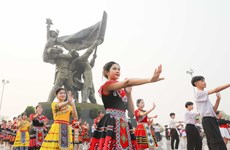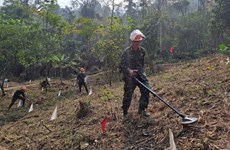The Epic of Hoang Sa Flotilla
The island district of Ly Son in the central province of Quang Ngai
has long preserved a historical story about the militia heroes of
the Hoang Sa Flotilla in the Nguyen Dynasty who rowed boats to Hoang Sa
Archipelago (Paracel), ready to plant sovereign landmarks and defend the
islands of the motherland.
The island district of Ly Son in the central province of Quang Ngai
has long preserved a historical story about the militia heroes of
the Hoang Sa Flotilla in the Nguyen Dynasty who rowed boats to Hoang Sa
Archipelago (Paracel), ready to plant sovereign landmarks and defend the
islands of the motherland.
Ly Son Island covers an area of less than 10 sq.km but it has nearly 100 relics, most of which are related to the Hoang Sa Flotilla, such as the sacred temple, the graves of Hoang Sa soldiers, the communal houses of An Vinh and An Hai Villages, the chambers worshipping Pham Quang Anh and Vo Van Khiet who were captains of the Hoang Sa Flotilla, the showroom displaying the items of the Hoang Sa Flotilla who also controlled Bac Hai and Ba Ri Lagoon. In particular, “Le khao le the linh Hoang Sa” (Feast and Commemoration Festival for Hoang Sa Soldiers) which is held every April on Ly Son Island has been recognised as a national intangible cultural heritage by the State.
As a custom, every year on this celebration day the natives of Ly Son Island, wherever they are living and working, return to their homeland to attend the ceremony to express their gratitude to their ancestors. The fishermen in the neighbouring provinces such as Binh Dinh, Phu Yen and Quang Nam also eagerly flock to the island to attend the ceremony because they consider it a common anniversary in the region.
“All Ly Son fishermen believe that when they go out to sea they will be helped and protected by the Hoang Sa Flotilla against big waves and strong winds. For them, this has become a belief,” said Pham Van Bien, a descendent of the 7 th generation of the well-known Pham family of the Hoang Sa Flotilla on Ly Son Island.
A monument and the memorial house dedicated to the Hoang Sa Flotilla stand near the main road of the island. The exhibits at the memorial house include the mats, identity cards, bamboo splints and rolls of rattan strings, which the militia-soldiers often took with them on each trip to Hoang Sa. In case a soldier died at sea, their team mates would use these things to wrap his body and release it to the sea, hoping that it would drift to the homeland on the waves.
Not a few soldiers died at sea and their bodies never found the way home, and that was the reason why there are hundreds of so-called “ wind” graves on the island. Local people said that in the old days, in February, the militia-soldiers of the Hoang Sa Flotilla went on their mission to Hoang Sa. In August if a soldier did not return, his family would know he had died. To have a grave to worship him, his family invited a monk to use the clay taken from the peak of the Gieng Tien Mountain, the earth from the T-junction, egg yolk and the twigs of a mulberry tree to make a dummy and bury it in a “wind” grave.
On the day of the ceremony, the sounds of the horns made of snail shells spread across the island and streams of people gathered at the communal house of An Vinh Village. The main altar was placed in the yard, facing the sea. Well-dressed elders of six large families on the island solemnly conducted the rituals, such as the requiem, the offering ritual for the captain and the launching of the boats with dummies to commemorate the Hoang Sa Flotillas.
This year, a tomb has been built for Pham Van Nhat, Captain of the Hoang Sa Flotilla, who led naval forces on multiple occasions to defend Hoang Sa (Paracel) archipelago nearly 200 years ago.
In the 17th year of the Minh Mang reign (1836), Nhat was assigned to lead boats to survey, plant milestones and erect steles of sovereignty on Hoang Sa. He died at sea in 1854 during a trip to the archipelago.
The Pham Van family dug a symbolic grave for the captain in An Vinh village.
For his contributions, Nhat’s name has been given to an island of Hoang Sa archipelago.
The Pham Van family is one of more than 40 families in Ly Son that provided manpower to naval defence squads that sailed to Hoang Sa and Truong Sa under royal orders to exploit resources and plant territorial markers to affirm the country’s sovereignty.-VNA
Ly Son Island covers an area of less than 10 sq.km but it has nearly 100 relics, most of which are related to the Hoang Sa Flotilla, such as the sacred temple, the graves of Hoang Sa soldiers, the communal houses of An Vinh and An Hai Villages, the chambers worshipping Pham Quang Anh and Vo Van Khiet who were captains of the Hoang Sa Flotilla, the showroom displaying the items of the Hoang Sa Flotilla who also controlled Bac Hai and Ba Ri Lagoon. In particular, “Le khao le the linh Hoang Sa” (Feast and Commemoration Festival for Hoang Sa Soldiers) which is held every April on Ly Son Island has been recognised as a national intangible cultural heritage by the State.
As a custom, every year on this celebration day the natives of Ly Son Island, wherever they are living and working, return to their homeland to attend the ceremony to express their gratitude to their ancestors. The fishermen in the neighbouring provinces such as Binh Dinh, Phu Yen and Quang Nam also eagerly flock to the island to attend the ceremony because they consider it a common anniversary in the region.
“All Ly Son fishermen believe that when they go out to sea they will be helped and protected by the Hoang Sa Flotilla against big waves and strong winds. For them, this has become a belief,” said Pham Van Bien, a descendent of the 7 th generation of the well-known Pham family of the Hoang Sa Flotilla on Ly Son Island.
A monument and the memorial house dedicated to the Hoang Sa Flotilla stand near the main road of the island. The exhibits at the memorial house include the mats, identity cards, bamboo splints and rolls of rattan strings, which the militia-soldiers often took with them on each trip to Hoang Sa. In case a soldier died at sea, their team mates would use these things to wrap his body and release it to the sea, hoping that it would drift to the homeland on the waves.
Not a few soldiers died at sea and their bodies never found the way home, and that was the reason why there are hundreds of so-called “ wind” graves on the island. Local people said that in the old days, in February, the militia-soldiers of the Hoang Sa Flotilla went on their mission to Hoang Sa. In August if a soldier did not return, his family would know he had died. To have a grave to worship him, his family invited a monk to use the clay taken from the peak of the Gieng Tien Mountain, the earth from the T-junction, egg yolk and the twigs of a mulberry tree to make a dummy and bury it in a “wind” grave.
On the day of the ceremony, the sounds of the horns made of snail shells spread across the island and streams of people gathered at the communal house of An Vinh Village. The main altar was placed in the yard, facing the sea. Well-dressed elders of six large families on the island solemnly conducted the rituals, such as the requiem, the offering ritual for the captain and the launching of the boats with dummies to commemorate the Hoang Sa Flotillas.
This year, a tomb has been built for Pham Van Nhat, Captain of the Hoang Sa Flotilla, who led naval forces on multiple occasions to defend Hoang Sa (Paracel) archipelago nearly 200 years ago.
In the 17th year of the Minh Mang reign (1836), Nhat was assigned to lead boats to survey, plant milestones and erect steles of sovereignty on Hoang Sa. He died at sea in 1854 during a trip to the archipelago.
The Pham Van family dug a symbolic grave for the captain in An Vinh village.
For his contributions, Nhat’s name has been given to an island of Hoang Sa archipelago.
The Pham Van family is one of more than 40 families in Ly Son that provided manpower to naval defence squads that sailed to Hoang Sa and Truong Sa under royal orders to exploit resources and plant territorial markers to affirm the country’s sovereignty.-VNA












